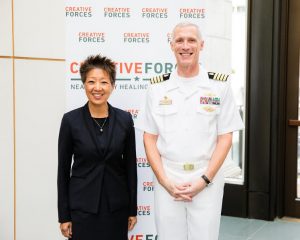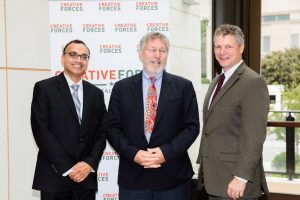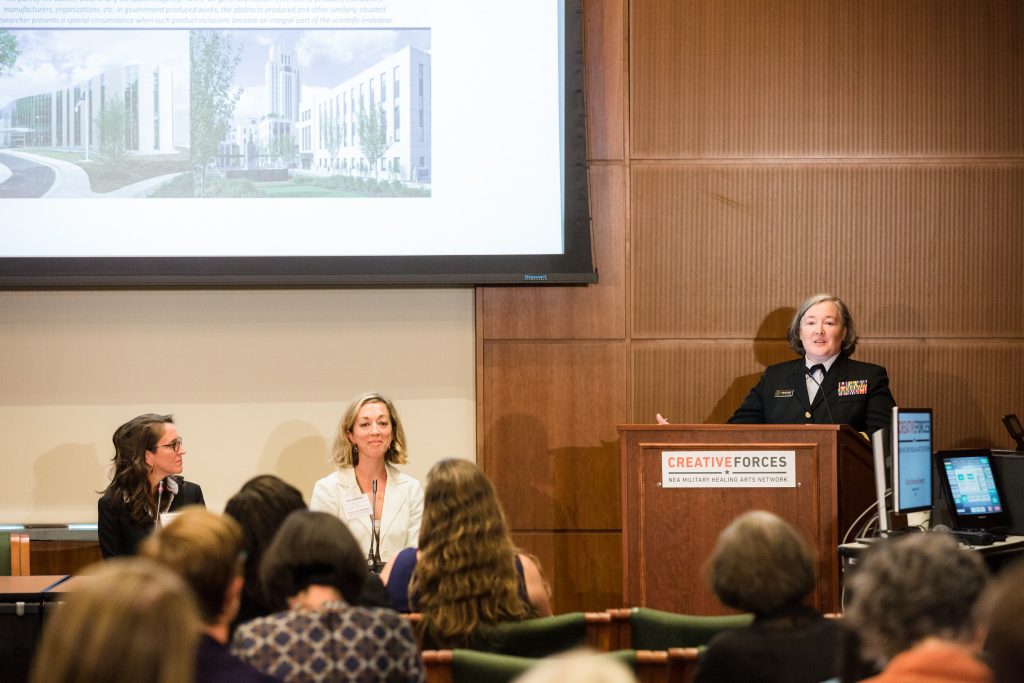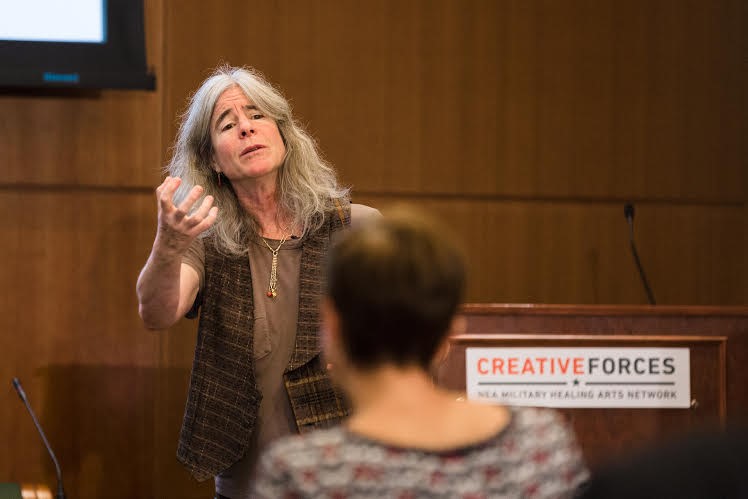By Adrienne M. Stamper, MA | October 5, 2017 | Veterans | Research | Events
The Creative Forces Clinical Research Summit took place on September 18th and 19th, 2017, at the National Academies of Science in Washington, DC. The intimate event gathered Department of Defense (DoD) and National Endowment for the Arts (NEA) collaborators to discuss clinical research findings and approaches for investigating creative arts therapies. The Summit aimed to develop a five-year research agenda, as part of the Creative Forces: NEA Military Healing Arts Network, which will be adapted into a formal report by the end of the year. Creative Forces was established in 2012 to serve the “unique and special needs of military patients and veterans who have been diagnosed with traumatic brain injury (TBI) and psychological health conditions [post-traumatic stress disorder] (PTSD), as well as their families and caregivers across the country.”
Creative Forces is encompassed by three domains: clinical, which supports medical research and formal creative arts therapy practice; capacity, which focuses on training, education, and building digital resources; and community, which partners with regional, state, and local arts organizations as well as veterans networks. By virtue of congressional support, Creative Forces has already reached 12 sites across the country (including 11 DoD and Veterans Affairs [VA] clinics and one telehealth program).
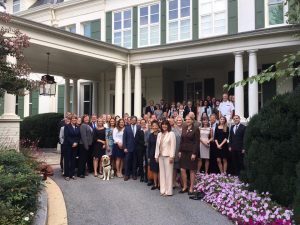
Summit participants gather for a photo on the grounds of the Naval Observatory. Official White House photo by Stephanie Chasez.
The Summit began with a breakfast kick-off hosted by Second Lady Karen Pence at the Vice President’s residence. Mrs. Pence reiterated her mission to advocate for the field of art therapy as a distinct mental health profession, and expressed gratitude towards the growing Creative Forces network, stating: “military service members and veterans deserve opportunities to heal from injuries sustained while fighting to protect our freedoms.” Notable leadership representation included: NEA Chairman, Jane Chu, PhD; NEA Senior Advisor for Innovation and Creative Forces Project Director, Bill O’Brien; NEA Research & Analysis Director, Sunil Iyengar; Americans for the Arts (AftA) President and CEO, Robert Lynch; AFTA Senior Director of Arts Policy, Marete Wester; Walter Reed National Military Medical Center (WRNMMC) Director, CAPT Mark Kobelja; National Intrepid Center of Excellence (NICoE) Director, CAPT Walter Greenhalgh; Defense and Veterans Brain Injury Center (DVBIC) Acting Director & NICoE Chief Innovations Officer, Thomas DeGraba; American Art Therapy Association (AATA) President, Donna Betts, PhD, ATR-BC; AATA Executive Director, Cynthia Woodruff, CAE (read the AATA Summit brief, here); American Dance Therapy Association (ADTA) President, Jody Wager, MS, BC-DMT; among others.
- NEA Chairman Jane Chu with WRNMMC Director CAPT Mark Kobelja at the National Academies of Science. Photo by Yassine El Mansouri courtesy of the National Endowment for the Arts.
- Summit Co-Chair, Sunil Iyengar (NEA), Keynote Speaker Dr. Bessel van der Kolk, and Bill O’Brien (NEA). Photo by Yassine El Mansouri courtesy of the NEA.
After introductions and a call-to-action led by NEA Chairman Chu and CAPT Kobelja, Summit co-chairs Sunil Iyengar (Director of Research and Analysis, NEA) and Dr. Thomas J. DeGraba (Acting Director, DVBIC & Chief Innovations Officer, NICoE) presented the Summit agenda, which featured an overview of current Creative Forces clinical research and practice, four distinguished keynote speakers, and four individual “spotlight” sessions (respectively: Art Therapy, Creative and Expressive Writing as Therapy, Dance/Movement Therapy, and Music Therapy). .
After the welcoming remarks, Sunil Iyengar (NEA); CAPT (Ret) Sara Kass (Creative Forces); Patricia Moore Shaffer, PhD, (NEA); Joke Bradt, PhD, MT-BC (Drexel U); and Dr. Tom DeGraba (DVBIC/NICoE) presented an overview of creative arts therapy practices across the Creative Forces sites. The overview included: a summary on the research synthesis and analysis report commissioned by the Creative Forces team, highlights from the Creative Forces evaluation toolkit, and an overview of the biometrics data collection infrastructure at the NICoE, focused on electrophysiology measurements.
World-renowned trauma expert Dr. Bessel van der Kolk delivered the first keynote lecture on the impacts of traumatic stress on mind, body, and society. Dr. Van der Kolk vividly depicted the ways that trauma can lead to torn perceptions of reality and how the creative arts therapies are uniquely suited to reconstruct them.
The keynote was followed by an impressive panel of art therapists, including: Melissa Walker, MA, ATR (NICoE); Jacqueline Jones, MA, MEd, ATR (Ft. Belvoir); Girija Kaimal, EdD, MA (Drexel U); Sarah Deaver, PhD, ATR-BC, HLM (EVMS, AATA); and Paula Howie, MA, ATR-BC, HLM (Washington, D.C.), and was moderated by Tom DeGraba, MD (DVBIC/NICoE). Each spoke to their distinctive roles as clinicians, program developers, and researchers within the military community. Current research was shared, highlighting a compelling case study as well as the thematic analysis of several hundred masks. One of the major themes that emerged during this panel was the power of art therapy to foster a sense of belonging and engagement⎯within the self, within the family, and within society. Through this, these men and women “are finally able to love and work again,” says Dr. Deaver. Also emphasized were the importance of program evaluations and study designs that investigate not only outcome measurements but also mechanisms of change. Each panelist provided a critical window into the unique sensitivities of working with the military population.

Art therapy spotlight session panelists and second spotlight presenters: Bill O’Brien (NEA); Girija Kaimal, EdD, MA (Drexel U); Paula Howie, MA, ATR-BC, HLM (Washington D.C.); Sarah Deaver, PhD, ATR-BC, HLM (EVMS, AATA); Melissa Walker, MA, ATR (NICoE); Jacqueline Jones, MA, MEd, ATR (Ft. Belvoir); moderator Tom DeGraba, MD (DVBIC/NICoE); and Summit Co-Chair Sunil Iyengar, Photo by Yassine El Mansouri courtesy of the NEA.
The second spotlight session explored the use of creative and expressive writing as therapy. Bill O’Brien (NEA) likened the process of therapeutic writing to Aristotle’s theory of catharsis, that is, “bringing intellectual clarity to emotional chaos.” Dr. Kaimal noted that masks created at the NICoE tended to represent themes surrounding identity, while the writing more often elicited relational content– perhaps a function of the medium itself. Dr. Charon, who pioneered the field of narrative medicine at Columbia University, stated poignantly that, “To represent our experiences is to expand our perceptions… we write in order to know who we are, and how we feel.”
- Dance therapy panelists Jennifer Tantia, PhD, MS, BC-DMT, LCAT (ADTA); Allison Winters, MA, MS, BC-DMT, LCAT, E-RYT (NICoE); and moderator CAPT. Moira McGuire (WRNMMC). Photo by Yassine El Mansouri courtesy of the NEA.
- “Creative and Expressive Writing as Therapy” spotlight session panelists Bill O’Brien (NEA), Dr. Rita Charon (Columbia U), Dr. Girija Kaimal (Drexel U) (AATA), and Melissa Walker (NICoE): Q&A. Photo by Yassine El Mansouri courtesy of the NEA.
- Dr. Nina Kraus delivering the third keynote lecture on TBI and auditory processing. Photo by Yassine El Mansouri courtesy of the NEA.
- Dr. Csikszentmihalyi, discussing “Flow” theory. Photo by Yassine El Mansouri courtesy of the NEA.
The third panel brought attention to the use of Dance/Movement Therapy within the military community, featuring Allison Winters, MA, MS, BC-DMT, LCAT, E-RYT (NICoE) and Jennifer Tantia, PhD, MS, BC-DMT, LCAT (ADTA), and moderated by CAPT Moira McGuire (WRNMMC). This discussion shed light on the crucial role that movement plays in the fight-flight-faint-or-freeze response, and how group rhythm and cadence are already built into basic training in order to facilitate unit cohesion. Ultimately, as Dr. Tantia observed, “the body wants to move–it’s the mind that keeps it still.”
Best-selling author and world-leader in the field of positive psychology, Dr. Mihaly Csikszentmihalyi, marked the second keynote, sharing the applicability of “Flow” theory to post-traumatic growth in combat veterans. Through his extensive interviews with professionals from a range of disciplines, Dr. Csikszentmihalyi found that the “secret to happiness” is when we are participating fully in what we do and are in total harmony with the environment around us–a condition that requires an even intersection between level of skill and level of challenge. Csikszentmihalyi’s work has profound implications for a population that often struggles to re-engage with their surroundings and experience positive emotions after returning from war.
Day two of the Summit commenced with a fascinating lecture on the role of music in TBI and auditory processing delivered by scientist, inventor, and musician Dr. Nina Kraus. Dr. Kraus shared her lab findings, which identified signature biomarkers for TBI related to auditory processing.
The final spotlight session illuminated the healing power of music therapy, featuring presentations by Rebecca Vaudreuil, EdM, MT-BC (NICoE); Hannah Bronson, MT-BC (Ft. Belvoir); Joke Bradt, PhD, MT-BC (Drexel U); and Wendy Magee, PhD (Temple U), and moderated by CAPT (Ret) Sara Kass (Creative Forces). One of the most prominent takeaways from the discussion that followed was the ability of music therapy to measure brain health and to “identify area of deficit and then address them” as Hannah Bronson puts it. Also striking was Rebecca Vaudreuil’s upcoming case study, co-authored with her patient, CAPT Luis Avila, to highlight the transformative role of music therapy in his rehabilitation (click here to watch their 2017 Memorial Day Concert performance).
- Music therapists Wendy Magee, PhD (Temple U); Joke Bradt, PhD, MT-BC (Drexel U); Hannah Bronson, MT-BC (Ft. Belvoir); and Rebecca Vaudreuil, EdM, MT-BC (NICoE), share a laugh during their “Spotlight on Music Therapy” panel. Photo by Yassine El Mansouri courtesy of the NEA.
- Dr. Edwards (NCCIH), describing the “Sound Health” initiative. Photo by Yassine El Mansouri courtesy of the NEA.
The final keynote speaker Dr. Emmeline Edwards (Director of the Division of Complementary and Integrative Health, National Center for Complementary and Integrative Health [NCCIH]), described the Sound Health initiative, which explored connections between music and the mind. Dr. Edwards encouraged creative arts therapists to seek NIH funding through new funding structures available through NCCIH.
The culminating discussion outlined several suggestions for future research within Creative Forces including: conducting a series of single-subject studies across sites in order to develop evidence for future randomized-control trials; conducting observational studies to identify the unique contribution of the creative arts therapies in promoting the health and well-being of service members and their families; developing theories of action for the creative arts therapies in the context of Creative Forces; seeking outcome measures that distinguish respective creative arts therapies from other interventions; standardizing and collecting of program evaluations across Creative Forces sites; assessing the value of creative arts therapies in integrated settings; and ensuring user-centric research designs.
Although each featured profession demonstrated its unique pathways for recovery, it became clear that, as a whole, “creativity is essential in response to pain and suffering” (Dr. Rita Charon, Columbia U). Ultimately, the Summit identified that the creative arts therapies can provide our wounded military service members and veterans with new ways of perceiving the world, connecting with others, and re-integrating post-deployment. The Summit closed with a touching rendition of the National Anthem, serving as a reminder of what brought us all together in the first place.

